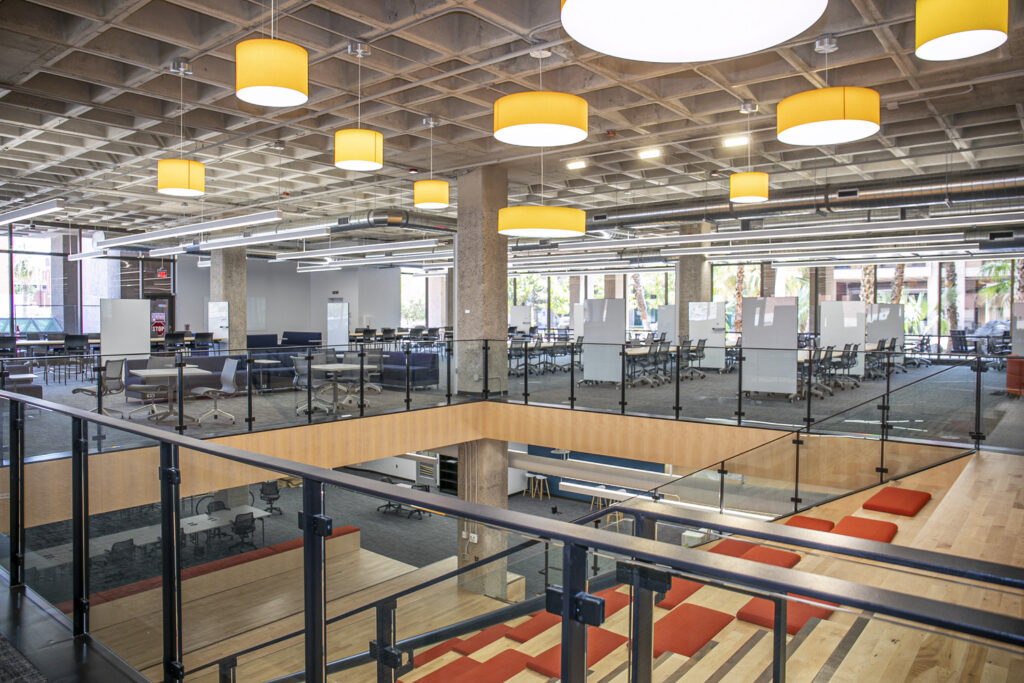
As contractors, we’re accustomed to navigating changes; we’re nimble in the way we adapt to meet the demands of new and emerging sectors, such as advanced technology. We also bring that same attention to sectors like higher education, a segment we’ve been building in since 1936.
Education is evolving to meet the needs of our changing world, and as such, contractors need to be cognizant of this evolution as we build on university campuses. More and more university systems are adopting interdisciplinary programs—degrees that meld together two or more perspectives or skills—which also offer students more career opportunities.
If you think about your college experience, you might remember spending time in the “Math” building or the “Engineering” building. For decades, we built university buildings that housed single colleges or departments. These don’t necessarily fit the needs of students any longer. Interdisciplinary degrees, such as environmental economics with policy, medicine with business management and biology with engineering, just make sense in today’s world.
“Now, universities are approaching careers, knowledge and teaching from a collaborative and innovative standpoint,” said Sundt Building Group Project Director Ben Perrone. “They’re taking traditionally independent learning programs and putting them together, essentially creating new career paths. Accordingly, we need to construct buildings to match these programs and give students the tools they need to be successful.”

One Team
The collaborative vision universities are adopting for their programs mirrors the process owners are implementing to construct their projects. Utilizing integrated teams, owners are asking how the variety of factors involved in blending previously disparate buildings into a singular product will impact value generation and functionality. Therefore, design-build contracts are gaining in popularity because the method is better for client dollars, saves time on delivery and it’s practical. “It’s part of a holistic look,” Ben explained.
For clients, design-build offers the total package. Builders are able to drive more value into their projects by involving all stakeholders up front. This process brings the whole team on board, from the university planners and teachers to the architects and engineers. Together, we’re all developing the package at the same time. The result is fewer change orders, and a more “perfect” version of the constructability of the design on paper before construction even begins.
For public owners, including many universities, design-build offers less surprises and more customization, which is crucial considering that most projects are publicly funded. The cost is transparent, as well as the vision of the final project.
“Sundt is unique in the way we do design-build. It’s a much more integrated process than what the traditional definition of design-build presents. We’re also sensitive to the design itself; we want the architect’s vision to come to life.” -Ben Perrone, Sundt Project Director
Case Study
Sundt’s award-winning design-build project at the University of Arizona, the Student Success District, is an example of these factors. The project was formed through a collaborative vision that brought together an array of student support services. These services were previously disconnected from one another in separate buildings, and today, they are joined together within one complex at the center of campus.
This project revitalized the Main Library, Weaver Science-Engineering Library and the historic Bear Down Gymnasium, merging them with the new Bartlett Academic Success Center to create a centralized point of support for the entire student body. The project’s main goal focused on the whole student, supporting and educating them not only on academic topics, but also how to be mentally, physically, financially and emotionally successful.
The design-build delivery method allowed the full team to co-create a functional program. “The start of the project was marked by collaborative meetings with Sundt, designers, university planners and end users to discuss space needs and how to achieve the project goals,” explained Senior Project Manager Tom Bersbach.
Based on input from all stakeholder groups, the team was able to locate where departments could share space, reducing the number of requested program spaces by nearly half. This resulted in substantial savings for the client. According to Tom, “These collaborative meetings built trust across the entire stakeholder group and laid the foundation for creative problem solving throughout the lifecycle of the project.”

The result of coalescing all student support services from around campus to a central location makes these resources more visible and accessible for students. The design-build method created a hub for student success, and the process made certain all client and end users have what they need to thrive.
And, the efforts paid off. The Student Success District project team has been awarded with several honors, including a national Award of Merit from the Design Build Institute of America (DBIA) in the Educational Facilities category and three awards from DBIA’s Northern Pacific Region: The Design Excellence Award, Award of Excellence for DEI in Design-Build, and The Innovation Award.
As contractors build more unique spaces on university campuses across the United States, it’s imperative that the voices of everyone are involved. Design-build offers the type of experience that results in higher-quality buildings that match the evolution of degree programs students pursue.
Learn more about Sundt’s work in higher-education.